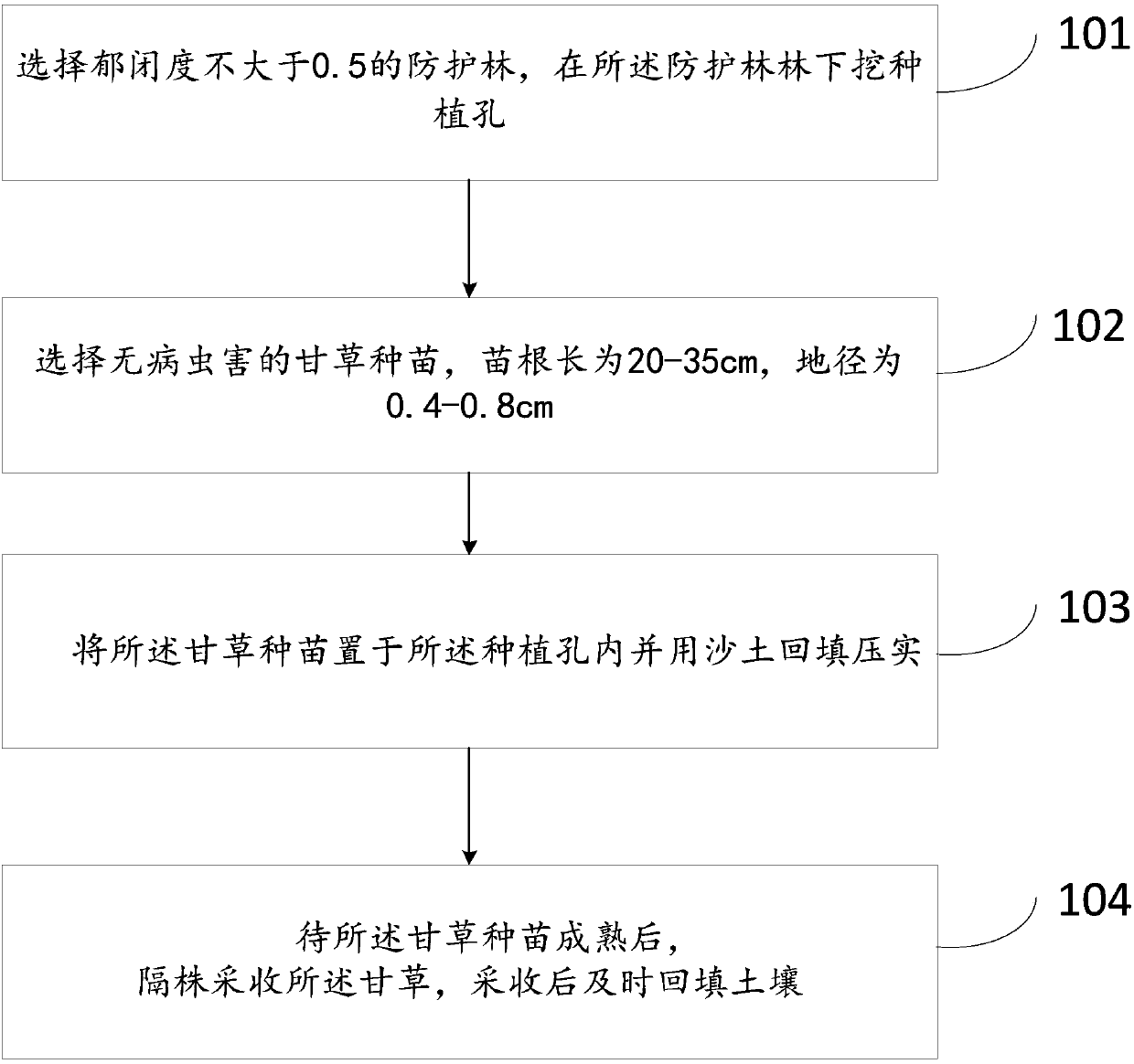Method for interplanting glycyrrhiza under afforestation in protection forest
It is a technology for interplanting and shelter forest under forest, which is applied in the fields of botany equipment and methods, horticulture, plant cultivation, etc. It can solve the problems of low vegetation coverage rate, single plant species, and poor tree growth under forest, so as to enhance ecological protection ability, The effect of improving soil fertility and improving coverage
- Summary
- Abstract
- Description
- Claims
- Application Information
AI Technical Summary
Problems solved by technology
Method used
Image
Examples
Embodiment 1
[0040] Embodiment 1 is a method for interplanting Glycyrrhizae uralensis under a Xinjiang poplar shelterbelt provided by the application, including:
[0041] Select the Xinjiang poplar shelterbelt with a canopy density of 0.5, and drill planting holes under the Xinjiang poplar shelterbelt.
[0042] In this example, the selected experimental site is Alar City, Xinjiang, at an altitude of 1100m, and the selected shelterbelt type is Xinjiang poplar shelterbelt, the width of the forest belt is 30m, and the row spacing of trees is 1.5m×3.0m. The soil type of the Xinjiang poplar shelterbelt is heavy saline-alkali soil, the total soil salt content is about 17.7g / kg, the soil pH value is 9.2, and the soil salinity is mainly sodium chloride. The climate of the Xinjiang poplar shelterbelt plantation is a temperate extreme continental desert arid climate, with long light hours, large temperature difference between day and night, low rainfall, and large evaporation. The annual average tem...
Embodiment 2
[0057] Embodiment 2 is a method for interplanting Glycyrrhiza inflata under a black mulberry shelterbelt provided by the present application, comprising:
[0058] Select a black mulberry shelterbelt with a canopy density of 0.3, and drill planting holes under the black mulberry shelterbelt.
[0059] In this example, the selected experimental site is Alar City, Xinjiang, 1100m above sea level, and the selected shelterbelt type is black mulberry shelterbelt, the width of the forest belt is 35m, and the row spacing of trees is 1.5m×3.0m. The soil type of the black mulberry shelterbelt is heavy saline-alkali soil, the total soil salt content is about 12.5g / kg, the soil pH value is 8.6, and the soil salinity is mainly sodium chloride. The climate of the black mulberry shelterbelt plantation is a temperate extreme continental desert arid climate, with long sunshine time, large temperature difference between day and night, low rainfall, large evaporation, annual average temperature o...
Embodiment 3
[0074] Embodiment 3 is a method for interplanting licorice glabra under a Populus euphratica shelterbelt provided by the present application, including:
[0075] Select a Populus euphratica shelterbelt with a canopy density of 0.2, and drill planting holes under the Populus euphratica shelterbelt.
[0076] In this example, the selected experimental site is Alar City, Xinjiang, at an altitude of 1100m, and the selected shelterbelt type is Populus euphratica shelterbelt, the width of the forest belt is 33m, and the row spacing of trees is 1.5m×3.0m. The soil type of the Populus euphratica shelterbelt is heavy saline-alkali soil, the total soil salt content is about 10.3g / kg, the soil pH value is 8.2, and the soil salinity is mainly sodium chloride. The climate of the Populus euphratica shelterbelt plantation is a temperate extreme continental desert arid climate, with long light hours, large temperature difference between day and night, low rainfall, large evaporation, annual av...
PUM
| Property | Measurement | Unit |
|---|---|---|
| Diameter | aaaaa | aaaaa |
| Depth | aaaaa | aaaaa |
| Plant distance | aaaaa | aaaaa |
Abstract
Description
Claims
Application Information
 Login to View More
Login to View More - R&D
- Intellectual Property
- Life Sciences
- Materials
- Tech Scout
- Unparalleled Data Quality
- Higher Quality Content
- 60% Fewer Hallucinations
Browse by: Latest US Patents, China's latest patents, Technical Efficacy Thesaurus, Application Domain, Technology Topic, Popular Technical Reports.
© 2025 PatSnap. All rights reserved.Legal|Privacy policy|Modern Slavery Act Transparency Statement|Sitemap|About US| Contact US: help@patsnap.com



